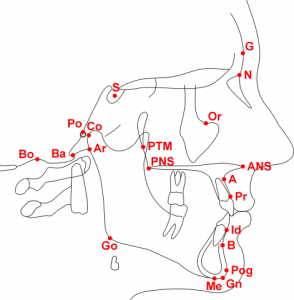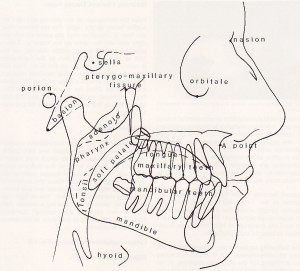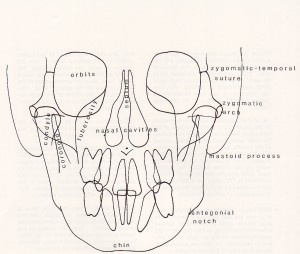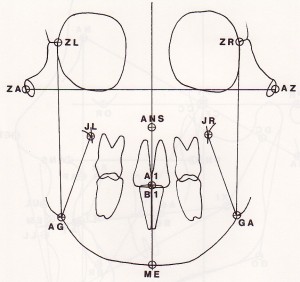Readily recognizable points on a cephalometric radiograph or tracing, representing certain hard or soft tissue anatomical structures (anatomical landmarks) or intersections of lines (constructed landmarks). Landmarks are used as reference points for the construction of various cephalometric lines or planes and for subsequent numerical determination of cephalometric measurements.
In the definitions of the specific landmarks the following convention is used: “midsagittal” identifies landmarks lying on the midsagittal plane, “unilateral” identifies landmarks corresponding to unilateral structures and “bilateral” applies to landmarks corresponding to bilateral structures.
SUBTERMS:
A-point (Point A, Subspinale, ss)
Anterior nasal spine (ANS)
Articulare (Ar)
B-point (Point B, Supramentale, sm)
Basion (Ba)
Bolton (Bo)
Condylion (Co)
Crista galli
Dacryon
Glabella (G)
Gnathion (Gn)
Gonion (Go)
Incision inferius (Ii)
Incision superius (Is)
Infradentale (Id, Inferior prosthion)
L-point
Menton (Me)
Nasion (N, Na)
Opisthion (Op)
Orbitale (Or)
Pogonion (Pog, P, Pg)
Porion (Po)
Posterior nasal spine (PNS)
Prosthion (Pr, Superior prosthion, Supradentale)
Pterygomaxillary fissure (PTM, Pterygomaxillare)
R-point (Registration point)
Sella (S)
Cervical point (C)
Inferior labial sulcus (Ils)
Labrale inferior (Li)
Labrale superior (Ls)
Pronasale (Pn)
Soft tissue glabella (G’)
Soft tissue menton (Me’)
Soft tissue nasion (N’, Na’)
Soft tissue pogonion (Pg’, Pog’)
Stomion (St)
Stomion inferius (Sti)
Stomion superius (Sts)
Subnasale (Sn)
Superior labial sulcus (Sls)
Trichion (Tr)
Soft tissue gnathion (Gn’)
Ricketts Anatomical Tracing
Ricketts Points and Planes
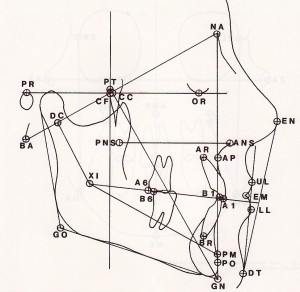
Ricketts Frontal Anatomy
A-point (Point A, Subspinale, ss)
The deepest (most posterior) midline point on the curvature between the ANS and prosthion. Its vertical coordinate is unreliable and therefore this point is used mainly for anteroposterior measurements. The location of A-point may change somewhat with root movement of the maxillary incisor teeth. (midsagittal)

Anterior nasal spine (ANS)
The tip of the bony anterior nasal spine at the inferior margin of the piriform aperture, in the midsagittal plane. It corresponds to the anthropological point acanthion and often is used to define the anterior end of the palatal plane (nasal floor). (midsagittal)
Articulare (Ar)
A constructed point representing the intersection of three radiographic images: the inferior surface of the cranial base and the posterior outlines of the ascending rami or mandibular condyles. It was meant to substitute condylion when the latter is not readily discernible. Any movement of the mandible (i.e. opening or closing) will change the location of articulare. (bilateral)

B-point (Point B, Supramentale, sm)
The deepest (most posterior) midline point on the bony curvature of the anterior mandible, between infradentale and pogonion. (midsagittal)
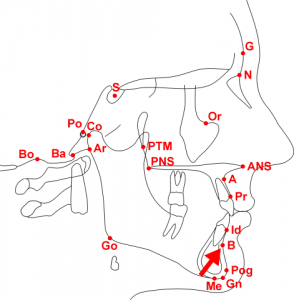
Basion (Ba)
The most anterior inferior point on the margin of the foramen magnum, in the midsagittal plane. It can be located by following the image of the slope of the inferior border of the basilar part of the occipital bone to its posterior limit, superior to the dens of the axis. (midsagittal)
Bolton (Bo)
The highest points on the outlines of the retrocondylar fossae of the occipital bone, approximating the center of the foramen magnum. Named after C. B. Bolton. (bilateral)

CC Point (CC) Ricketts
(Cranial Center) Crossing of the facial axis with the BaN plane
Cervical point (C)
The innermost point between the submental area and the neck in the midsagittal plane. Located at the intersection of lines drawn tangent to the neck and submental areas. (midsagittal)

Condylion (Co)
The most superior posterior point on the head of the mandibular condyle. (bilateral)
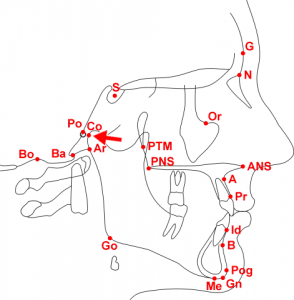
Crista galli
A vertically elongated, diamond-shaped radiopacity, appearing between the orbital outlines on postero-anterior cephalometric radiographs. Its location is used to establish a midsagittal reference plane. (midsagittal)

Dacryon
The point of intersection of the frontomaxillary, lacrimomaxillary and frontolacrimal sutures. An anatomic reference point used to record interorbital distance. (bilateral) Orbital hypertelorism
The increased distance between the medial orbital walls, reflecting an increased distance between the orbits (greater than 2 standard deviations from the norm). The anatomic landmarks used commonly for the measure-ment of interorbital distance are the dacryon points (bilaterally). Hypertelorism is described on the basis of skeletal measurements, because the presence of epicanthal folds or strabismus (exotropia), or other soft-tissue variations such as increased distance between the medial canthi (telecanthus) clinically may give a false impression of hypertelorism. Orbital hypertelorism is common in a number of craniofacial malformations such as Crouzon syndrome and frontonasal dysplasia.
Compare with Telecanthus

DC Point (Ricketts)
Center of the neck of the condyle on the Basion Nasion line.
Glabella (G)
The most prominent point of the anterior contour of the frontal bone in the midsagittal plane. (midsagittal)

Gnathion (Gn)
The most anterior inferior point on the bony chin in the midsagittal plane. (midsagittal)
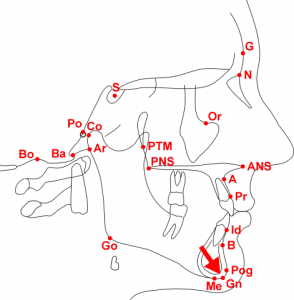
Gonion (Go)
The most posterior inferior point on the outline of the angle of the mandible. It may be determined by inspection or it can be constructed by bisecting the angle formed by the intersection of the mandibular plane and the ramal plane and by extending the bisector through the mandibular border. (bilateral)
Infradentale (Id) Inferior prosthion Pr
The most superior anterior point on the mandibular alveolar process, between the central incisors. (midsagittal)
Incision inferius (Ii) or B1 (Ricketts)
The incisal tip of the most labially placed mandibular incisor. (unilateral)
Incisian Inferius Root or BR (Ricketts)
Incision superius (Is) or A1 (Ricketts)
The incisal tip of the most labially placed maxillary central incisor. (unilateral)
Incision Superious Root or AR (Ricketts)
L-point
A point located in the anterior surface of the cortical plate, labial to the apices of the maxillary central incisors. Introduced by F. P. G. M. van der Linden, as a point representing the anterior border of the maxillary apical area. (midsagittal)
Labrale inferior (Li)

The point denoting the vermilion border of the lower lip, in the midsagittal plane. (midsagittal)
Labrale superior (Ls)
The point denoting the vermilion border of the upper lip, in the midsagittal plane. (midsagittal)
Menton (Me)
The most inferior point of the mandibular symphysis, in the midsagittal plane. (midsagittal)

Molar Upper First (Ricketts)
Point on the occlusal plane perpendicular to the distal surface of the crown of the upper first molar.
Molar Lower First (Ricketts)
Point on the occlusal plane perpendicular to the distal surface of the crown of the lower first molar.
Nasion (N, Na)
The intersection of the internasal and frontonasal sutures, in the midsagittal plane. (midsagittal)
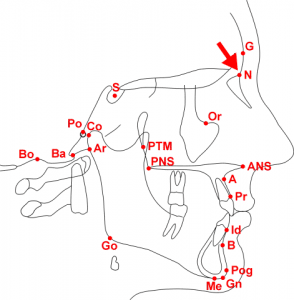
Opisthion (Op)
The most posterior inferior point on the margin of the foramen magnum, in the midsagittal plane. (midsagittal)
Orbitale (Or)
The lowest point on the inferior orbital margin. (bilateral)
Pogonion (Pog, P, Pg)
The most anterior point on the contour of the bony chin, in the midsagittal plane. Pogonion can be located by drawing a perpendicular to mandibular plane, tangent to the chin. (midsagittal)
Porion (Po)
The most superior point of the outline of the external auditory meatus (“anatomic porion”). When the anatomic porion cannot be located reliably, the superior-most point of the image of the ear rods (“machine porion”) sometimes is used instead. (bilateral)
Posterior nasal spine (PNS)
The most posterior point on the bony hard palate in the midsagittal plane; the meeting point between the inferior and the superior surfaces of the bony hard palate (nasal floor) at its posterior aspect. It can be located by extending the anterior wall of the pterygopalatine fossa inferiorly, until it intersects the floor of the nose. (midsagittal)
Pronasale (Pn)
The most prominent point of the tip of the nose, in the midsagittal plane. (midsagittal)
Prosthion (Pr, Superior prosthion, Supradentale)
The most inferior anterior point on the maxillary alveolar process, between the central incisors. (midsagittal)
Protruberance Menti (Pm) or Supra pogonion (Ricketts)
A point where the curvature of the anterior border of the symphysis changes from concave to convex,
Pterygoid Point (Pt) Ricketts
Lower lip of foramen rotundum (Represents the position of the sphenoid bone) posterior superior tangent of the pterygomaxillary fissure
Pterygoid Root (Pr) Ricketts
Most posterior point on the outlines of the pterygopalatine fossa
Pterygomaxillary fissure (PTM, Pterygomaxillare)
A bilateral, inverted teardrop-shaped radiolucency, whose anterior border represents the posterior surfaces of the tuberosities of the maxilla. The landmark is taken at the most inferior point of the fissure, where the anterior and the posterior outline of the inverted teardrop merge with each other. (bilateral)
R-point (Registration point)
A cephalometric reference point for registration of superimposed tracings, introduced by B. H. Broadbent, Sr. , in his original presentation of the cephalometric technique. It is the midpoint on a perpendicular drawn from sella to the Bolton-nasion line. (midsagittal)
Sella (S)
The geometric center of the pituitary fossa (sella turcica), determined by inspectionóa constructed point in the midsagittal plane. (midsagittal)
Soft tissue glabella (Gí)
The most prominent point of the soft tissue drape of the forehead, in the midsagittal plane. (midsagittal)
Soft tissue menton (Meí)
The most inferior point of the soft tissue chin, in the midsagittal plane. (midsagittal)
Soft tissue nasion (Ní, Naí)
The deepest point of the concavity between the forehead and the soft tissue contour of the nose in the midsagittal plane. (midsagittal)
Soft tissue pogonion (Pgí, Pogí)
The most prominent point on the soft tissue contour of the chin, in the midsagittal plane. (midsagittal)
Stomion (St)
The most anterior point of contact between the upper and lower lip in the midsagittal plane. When the lips are apart at rest, a superior and an inferior stomion point can be distinguished. (midsagittal)
Stomion inferius (Sti)
The highest midline point of the lower lip. (midsagittal) if lips are apart
Stomion superius (Sts)
The lowest midline point of the upper lip. (midsagittal) if lips are apart
Subnasale (Sn)
The point in the midsagittal plane where the base of the columella of the nose meets the upper lip. (midsagittal)
Superior labial sulcus (Sls) Soft Tissue Point A
The point of greatest concavity on the contour of the upper lip between subnasale and labrale superius, in the midsagittal plane. (midsagittal)
Soft Tissue B or Inferior labial sulcus (Ils)
The point of greatest concavity on the contour of the lower lip between labrale inferius and menton, in the midsagittal plane. (midsagittal)
Trichion (Tr)
An anthropometric landmark, defined as the demarcation point of the hairline in the midline of the forehead. (midsagittal)
Xi Point (Xi) approximate for Inferior alveolar foramen (Ricketts)
A constructed point located at the geographic center of the ramus as indicated below.

